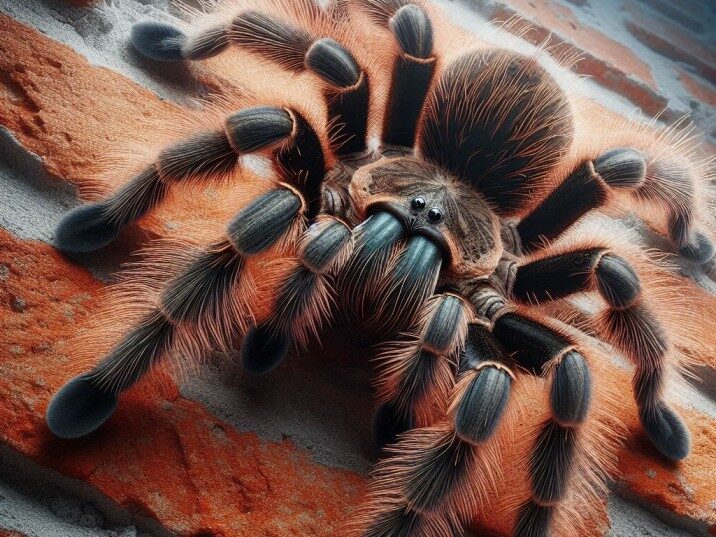Table of Contents
Table of Contents
- Introduction
- Understanding Tarantula Anatomy
- Tarantula Climbing Abilities
- How Do Tarantulas Climb Walls?
- Can All Tarantulas Climb?
- Environmental Factors Affecting Climbing
- Safety Concerns and Pet Tarantulas
- Common Misconceptions About Tarantulas and Climbing
- Conclusion
- Frequently Asked Questions
Introduction
When you think of tarantulas, you might imagine them crawling on the ground or lurking in dark corners. But have you ever wondered if these fascinating creatures can scale vertical surfaces? Can tarantulas climb walls? This blog post aims to demystify this intriguing aspect of tarantula behavior. Whether you’re a curious nature enthusiast, a pet owner, or someone who wants to learn more about these creatures, this article will provide you with a comprehensive understanding of tarantulas’ climbing abilities.

Understanding Tarantula Anatomy
The Basics of Tarantula Physiology
Tarantulas belong to the arachnid family, and their anatomy is specifically adapted for their predatory lifestyle. Key features include:
- Exoskeleton: Provides structural support and protection.
- Legs: Eight legs equipped with tiny hairs called setae.
- Spinnerets: Used for spinning silk.
- Fangs: Used for injecting venom into prey.
The Role of Setae
The setae on tarantulas’ legs are essential for climbing. These tiny hair-like structures increase surface area and enhance grip on various surfaces. Some setae even have microscopic claws that can latch onto rough textures, enabling tarantulas to navigate complex terrains.
Tarantula Climbing Abilities
Climbing Mechanics
Tarantulas are capable climbers, thanks to the special adaptations in their legs and feet. The main elements that aid in their climbing abilities are:
- Claw tufts: Soft, cushion-like pads at the end of their legs.
- Claws: Tarantulas have retractable claws that help them grasp surfaces.
- Adhesive setae: Provide additional grip and allow tarantulas to adhere to smooth surfaces like glass.
Types of Surfaces
Tarantulas can climb a variety of surfaces, including:
- Tree trunks and branches: Their natural habitat often requires them to navigate vertical surfaces.
- Walls: Smooth walls may present a challenge, but tarantulas can still manage with the help of their setae.
- Glass: While more difficult, some tarantulas can even scale glass, although they may struggle to maintain a grip.
How Do Tarantulas Climb Walls?
Surface Interaction
Tarantulas climb walls by using their setae to adhere to tiny imperfections on the surface. The process involves:
- Finding grip points: Using their sensitive legs to locate minuscule crevices or rough patches.
- Applying pressure: Pushing their legs against the wall to maximize surface contact.
- Adjusting their posture: Shifting their weight to maintain balance and prevent slipping.
The Role of Silk
In addition to their physical adaptations, tarantulas use silk to aid their climbing. They may spin small anchors of silk on the surface, providing additional stability and helping them to avoid falls.
Can All Tarantulas Climb?
Arboreal vs. Terrestrial Tarantulas
Not all tarantulas are equally adept at climbing. Their climbing abilities can be categorized based on their habitat:
- Arboreal tarantulas: These tarantulas live in trees and are naturally skilled climbers. They have longer legs and more pronounced setae to assist in scaling vertical surfaces.
- Terrestrial tarantulas: Ground-dwelling tarantulas are less proficient climbers. While they can manage short climbs, they typically prefer to stay closer to the ground.
Species Variability
The climbing abilities of tarantulas can also vary between species. Some species, like the Pink-toe Tarantula (Avicularia avicularia), are exceptional climbers and can navigate smooth surfaces with ease. Others, such as the Goliath Birdeater (Theraphosa blondi), are more robust and less agile when it comes to climbing.
Environmental Factors Affecting Climbing
Humidity and Surface Moisture
Humidity and surface moisture play a significant role in a tarantula’s ability to climb. High humidity can enhance the adhesion properties of their setae, making it easier to grip surfaces. Conversely, dry conditions may reduce their climbing efficiency.
Surface Texture
The texture of the surface also affects climbing capabilities. Rough surfaces provide more grip points for tarantulas, while smooth surfaces like glass require them to rely heavily on their setae and claws.
Temperature
Temperature can influence tarantula behavior and muscle function. Warmer temperatures may enhance their agility and climbing efficiency, while colder temperatures could slow them down and make climbing more challenging.
Safety Concerns and Pet Tarantulas
Preventing Escapes
For pet owners, understanding a tarantula’s climbing abilities is crucial for preventing escapes. Here are some tips:
- Secure enclosures: Use enclosures with secure lids to prevent tarantulas from climbing out.
- Smooth walls: Opt for enclosures with smooth walls to make it more difficult for tarantulas to climb.
- Regular checks: Inspect the enclosure regularly for any potential escape routes.
Handling with Care
When handling pet tarantulas, it’s essential to be aware of their climbing tendencies. Always handle them gently and close to a surface to prevent falls, as tarantulas are delicate and can be injured by even short drops.
Common Misconceptions About Tarantulas and Climbing
Myth 1: Tarantulas Can Climb Any Surface
While tarantulas are skilled climbers, they cannot climb every surface. Extremely smooth surfaces like glass can pose a significant challenge.
Myth 2: Tarantulas Use Webs to Climb
Tarantulas do not use webs in the same way as spiders like orb-weavers. They may use silk to stabilize themselves or create a climbing anchor, but they primarily rely on their physical adaptations for climbing.
Myth 3: All Tarantulas Are Equally Good Climbers
As discussed earlier, not all tarantulas have the same climbing abilities. Arboreal species are typically better climbers than terrestrial ones.
Conclusion
Tarantulas are fascinating creatures with a unique set of skills that enable them to climb walls and navigate their environment effectively. Understanding their climbing abilities not only enhances our appreciation of these arachnids but also helps pet owners ensure the safety and well-being of their tarantulas. By debunking common myths and providing practical advice, we hope this article has shed light on the captivating world of tarantulas and their climbing prowess.
Frequently Asked Questions
1. Can tarantulas climb smooth surfaces like glass?
Yes, some tarantulas can climb smooth surfaces like glass using their setae, but it is more challenging for them than climbing rough surfaces.
2. Do all tarantulas climb walls?
Not all tarantulas are equally adept at climbing. Arboreal species are better climbers, while terrestrial species may struggle with vertical surfaces.
3. Why do tarantulas climb walls?
Tarantulas may climb walls to explore their environment, search for prey, or find a more suitable location for their burrow.
4. Can pet tarantulas escape by climbing out of their enclosure?
Yes, pet tarantulas can escape if their enclosure is not properly secured. It is essential to use enclosures with tight-fitting lids and smooth walls to prevent escapes.
5. How can I prevent my tarantula from climbing and escaping?
Ensure that the enclosure has a secure lid, use smooth-walled enclosures, and regularly inspect for any potential escape routes.

